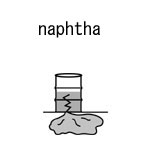| Case Name |
Small leakage of naphtha from an opening caused due to corrosion of air piping for decoking at an ethylene manufacturing unit |
| Pictograph |

|
| Date |
September 3, 1986 |
| Place |
Kawasaki, Kanagawa, Japan |
| Location |
Chemical factory |
| Overview |
A hole was made in a decoking air piping of a naphtha cracking furnace at an ethylene manufacturing plant during usual operation, and naphtha leaked. The cause of the opening of the hole was a decrease in pipe wall thickness, which was induced by corrosion of the inside and outside surfaces of the piping for long-term use. SGP piping with 3.2 mm wall thickness was misused instead of STPG38 piping with 4.5 mm wall thickness, which meets the design specification, and it accelerated hole-opening. |
| Incident |
A hole was made in decoking air piping of a naphtha cracking furnace at an ethylene manufacturing plant during usual operation, and naphtha leaked. |
| Processing |
Manufacture |
| Individual Process |
Reaction |
| Process Flow |
Fig2.Unit process flow
|
| Chemical Reaction |
Other (Cracking) |
| Substance |
Naphtha |
| Type of Accident |
Leakage |
| Sequence |
On August 12th and 13th, 1986: A naphtha cracking furnace restarted after decoking the naphtha cracking tube. After that, it worked smoothly.
About 11:00 September 3rd, a maintenance person found a fog of naphtha leaking from the decoking air piping. He informed the control room immediately.
An operator of the manufacturing group rushed to the leakage site. He confirmed that the leakage position was near the furnace. The supply of naphtha was stopped immediately, and an emergency shut-down of the furnace was carried out.
Decoking: Work to remove carbon in a cracking tube by burning it off with steam and air. |
| Cause |
1. Naphtha leaked from an opening of the decoking air piping caused due to corrosion.
2. As a result of an investigation, the cause of the opening in the piping was considered to be as follows:
(1) The thickness of piping was decreased about 1-2.5 mm due to internal corrosion. Water which was generated by condensation of steam was affected by sulfur from naphtha, and reacted with the pipe wall.
(2) External surface corrosion also advanced at the piping, and there was a partially decrease of thickness of about 0.3~0.5 mm.
(3) The design specification of the pipe was STPG38 (4.5 mm in wall thickness), but, SGP (3.2 mm in wall thickness) was misused. |
| Response |
The naphtha cracking furnace was stopped urgently. The naphtha was prevented from splashing by putting a fire-preventing sheet at the leakage place. Temporary measures that stopped the leak using a rubber belt were carried out after stopping the supply of naphtha at the leakage position. |
| Countermeasures |
1. Decoking air piping of the furnace was changed completely before re-starting.
2. A protective coating was applied again on decoking air piping of all other naphtha-cracking furnaces, and wall thickness was measured.
3. Inspection was done to check the positions where utility piping of the ethylene plant was connected with the process. |
| Knowledge Comment |
1. Attention is necessary at a position where utility piping is directly connected with the process. It is necessary to check it periodically because there is a possibility of corrosion caused by process fluid in a counter-flow.
2. In piping work, pipe material should be displayed to prevent misuse of pipe. It is also necessary to check misuse of pipe material at inspections of piping. |
| Background |
The cause was corrosion on inside and outside surfaces of a small-diameter pipe which had been used for a long time. The problem was inadequate facility management. At least the outside surface corrosion should have been found in daily inspection. As for the inside surface, the used air was saturated with moisture and a little corrosive, so internal surface corrosion should have been considered.
It is also the problem to have used piping of different material from the design specification. Selecting SGP was not a mistake from the viewpoint of resisting pressure, but it was misused in a corrosive environment. |
| Incidental Discussion |
The decoking air is moistened and compressed atmospheric air. It can become acidic if carbon dioxide and sulfurous acid gas is in the atmosphere. Also, there is some sulfur in naphtha. A corrosive condition can easily be generated. |
| Reason for Adding to DB |
Example of leakage caused due to corrosion of piping |
| Scenario |
| Primary Scenario
|
Poor Value Perception, Poor Safety Awareness, Inadequate Risk Recognition, Organizational Problems, Poor Management, Slackness of Management, Usage, Maintenance/Repair, No Inspection for a Long Period, Production, Hardware Production, Bad Selection of Piping Material, Failure, Abrasion, Corrosion, Secondary Damage, External Damage, Leakage
|
|
| Sources |
High Pressure Gas Safety Inst. of Japan. High pressure gas protection overview. pp.198-199(1993).
High Pressure Gas Safety Inst. of Japan. Ethylene manufacturing plant. Naphtha leakage from air piping for decoking. Accident examples of Petroleum refinery and Petrochemical units. pp.109-112(1995)
|
| Physical Damage |
2-3 liters of the naphtha |
| Field |
Chemicals and Plants
|
| Author |
DOBASHI, Ritsu (School of Engineering, The University of Tokyo)
TAMURA, Masamitsu (Center for Risk Management and Safety Sciences, Yokohama National University)
|